The Canadian Economy: Addressing the Lack of Diversification
VerifiedAdded on 2023/04/23
|8
|1924
|438
Essay
AI Summary
This essay examines the most significant economic problem facing Canada today: the lack of diversification. It highlights how Canada's economy heavily relies on a few sectors like finance, energy, and materials, making it vulnerable to economic shocks. The essay also discusses the potential for a recession due to rising gas prices, interest rates, and reduced home sales. It further explores the issues of poverty and the need for improved education. The author suggests that if they were the Minister of Finance, they would focus on reducing government deficits by cutting wasteful spending and prioritizing essential sectors. The essay concludes by arguing that Canada could benefit from becoming part of the United States, citing potential economic stability and increased job opportunities. Desklib provides a platform for students to access similar solved assignments and past papers.
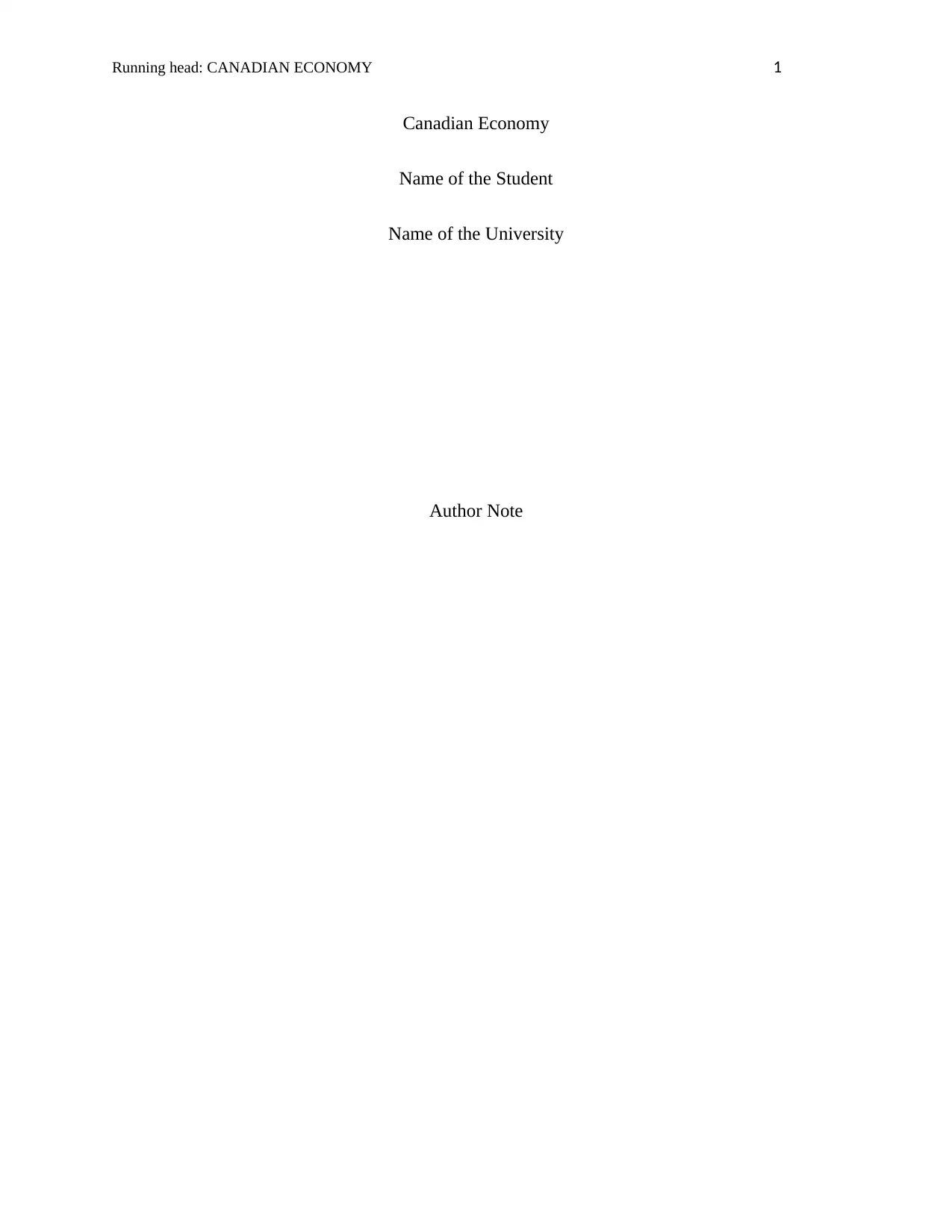
Running head: CANADIAN ECONOMY 1
Canadian Economy
Name of the Student
Name of the University
Author Note
Canadian Economy
Name of the Student
Name of the University
Author Note
Paraphrase This Document
Need a fresh take? Get an instant paraphrase of this document with our AI Paraphraser
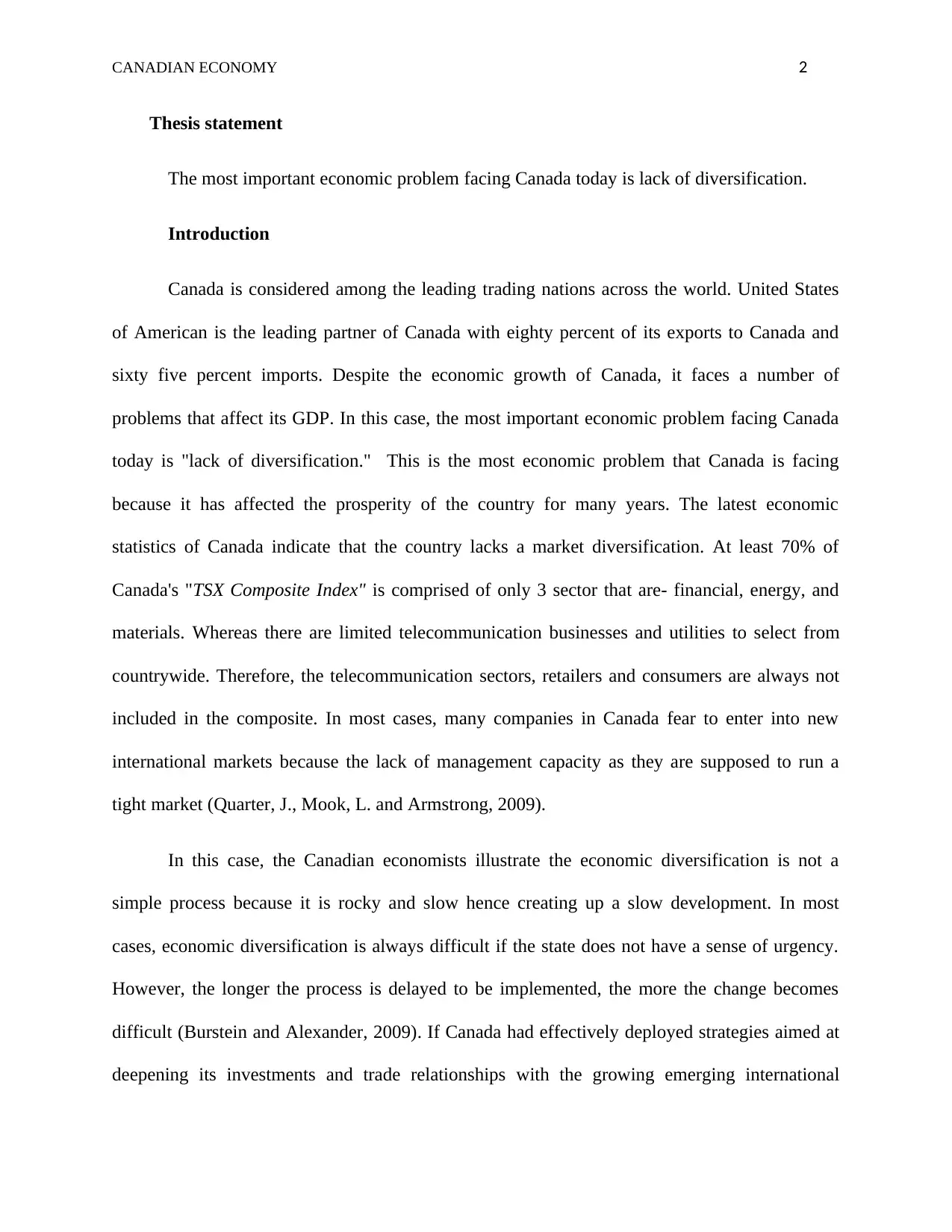
CANADIAN ECONOMY 2
Thesis statement
The most important economic problem facing Canada today is lack of diversification.
Introduction
Canada is considered among the leading trading nations across the world. United States
of American is the leading partner of Canada with eighty percent of its exports to Canada and
sixty five percent imports. Despite the economic growth of Canada, it faces a number of
problems that affect its GDP. In this case, the most important economic problem facing Canada
today is "lack of diversification." This is the most economic problem that Canada is facing
because it has affected the prosperity of the country for many years. The latest economic
statistics of Canada indicate that the country lacks a market diversification. At least 70% of
Canada's "TSX Composite Index" is comprised of only 3 sector that are- financial, energy, and
materials. Whereas there are limited telecommunication businesses and utilities to select from
countrywide. Therefore, the telecommunication sectors, retailers and consumers are always not
included in the composite. In most cases, many companies in Canada fear to enter into new
international markets because the lack of management capacity as they are supposed to run a
tight market (Quarter, J., Mook, L. and Armstrong, 2009).
In this case, the Canadian economists illustrate the economic diversification is not a
simple process because it is rocky and slow hence creating up a slow development. In most
cases, economic diversification is always difficult if the state does not have a sense of urgency.
However, the longer the process is delayed to be implemented, the more the change becomes
difficult (Burstein and Alexander, 2009). If Canada had effectively deployed strategies aimed at
deepening its investments and trade relationships with the growing emerging international
Thesis statement
The most important economic problem facing Canada today is lack of diversification.
Introduction
Canada is considered among the leading trading nations across the world. United States
of American is the leading partner of Canada with eighty percent of its exports to Canada and
sixty five percent imports. Despite the economic growth of Canada, it faces a number of
problems that affect its GDP. In this case, the most important economic problem facing Canada
today is "lack of diversification." This is the most economic problem that Canada is facing
because it has affected the prosperity of the country for many years. The latest economic
statistics of Canada indicate that the country lacks a market diversification. At least 70% of
Canada's "TSX Composite Index" is comprised of only 3 sector that are- financial, energy, and
materials. Whereas there are limited telecommunication businesses and utilities to select from
countrywide. Therefore, the telecommunication sectors, retailers and consumers are always not
included in the composite. In most cases, many companies in Canada fear to enter into new
international markets because the lack of management capacity as they are supposed to run a
tight market (Quarter, J., Mook, L. and Armstrong, 2009).
In this case, the Canadian economists illustrate the economic diversification is not a
simple process because it is rocky and slow hence creating up a slow development. In most
cases, economic diversification is always difficult if the state does not have a sense of urgency.
However, the longer the process is delayed to be implemented, the more the change becomes
difficult (Burstein and Alexander, 2009). If Canada had effectively deployed strategies aimed at
deepening its investments and trade relationships with the growing emerging international
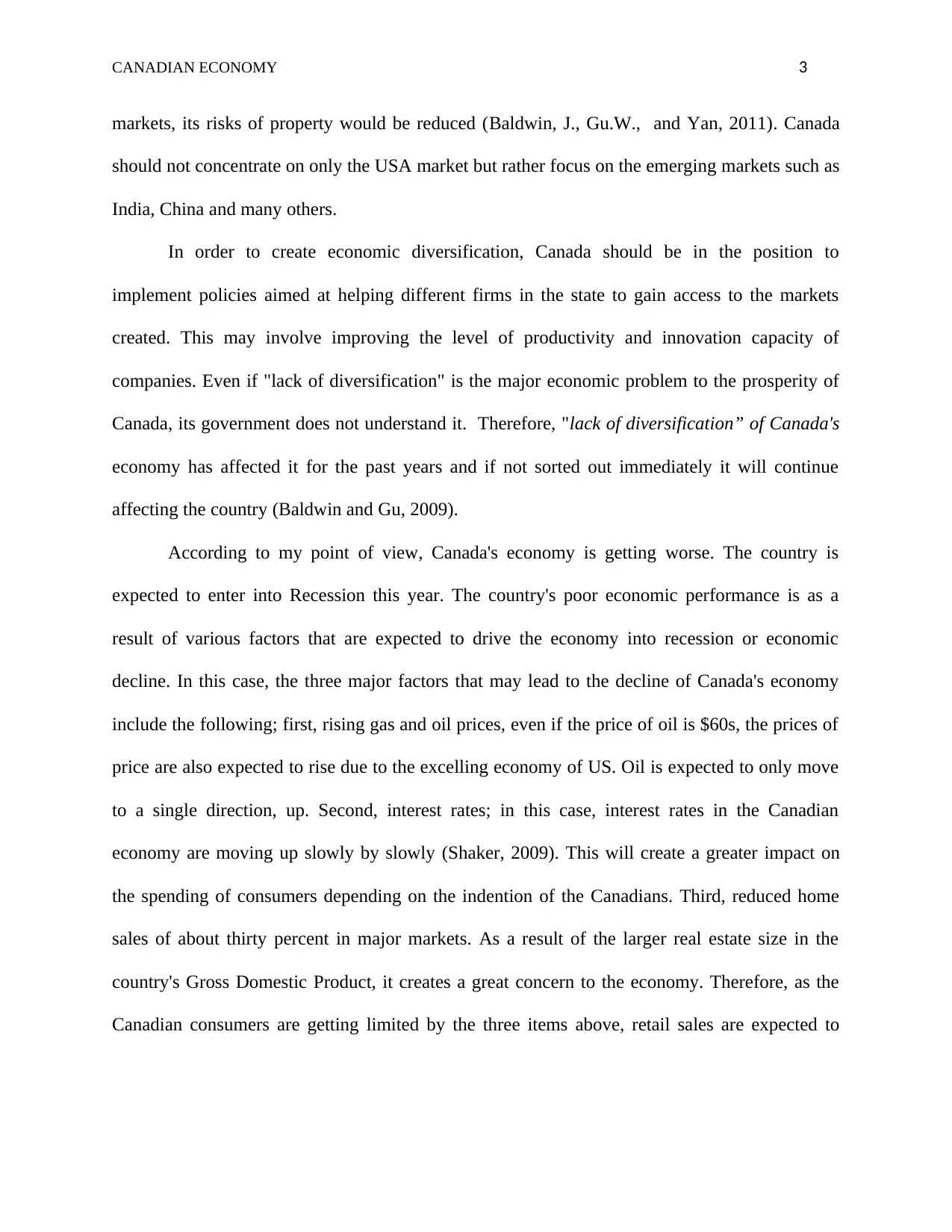
CANADIAN ECONOMY 3
markets, its risks of property would be reduced (Baldwin, J., Gu.W., and Yan, 2011). Canada
should not concentrate on only the USA market but rather focus on the emerging markets such as
India, China and many others.
In order to create economic diversification, Canada should be in the position to
implement policies aimed at helping different firms in the state to gain access to the markets
created. This may involve improving the level of productivity and innovation capacity of
companies. Even if "lack of diversification" is the major economic problem to the prosperity of
Canada, its government does not understand it. Therefore, "lack of diversification” of Canada's
economy has affected it for the past years and if not sorted out immediately it will continue
affecting the country (Baldwin and Gu, 2009).
According to my point of view, Canada's economy is getting worse. The country is
expected to enter into Recession this year. The country's poor economic performance is as a
result of various factors that are expected to drive the economy into recession or economic
decline. In this case, the three major factors that may lead to the decline of Canada's economy
include the following; first, rising gas and oil prices, even if the price of oil is $60s, the prices of
price are also expected to rise due to the excelling economy of US. Oil is expected to only move
to a single direction, up. Second, interest rates; in this case, interest rates in the Canadian
economy are moving up slowly by slowly (Shaker, 2009). This will create a greater impact on
the spending of consumers depending on the indention of the Canadians. Third, reduced home
sales of about thirty percent in major markets. As a result of the larger real estate size in the
country's Gross Domestic Product, it creates a great concern to the economy. Therefore, as the
Canadian consumers are getting limited by the three items above, retail sales are expected to
markets, its risks of property would be reduced (Baldwin, J., Gu.W., and Yan, 2011). Canada
should not concentrate on only the USA market but rather focus on the emerging markets such as
India, China and many others.
In order to create economic diversification, Canada should be in the position to
implement policies aimed at helping different firms in the state to gain access to the markets
created. This may involve improving the level of productivity and innovation capacity of
companies. Even if "lack of diversification" is the major economic problem to the prosperity of
Canada, its government does not understand it. Therefore, "lack of diversification” of Canada's
economy has affected it for the past years and if not sorted out immediately it will continue
affecting the country (Baldwin and Gu, 2009).
According to my point of view, Canada's economy is getting worse. The country is
expected to enter into Recession this year. The country's poor economic performance is as a
result of various factors that are expected to drive the economy into recession or economic
decline. In this case, the three major factors that may lead to the decline of Canada's economy
include the following; first, rising gas and oil prices, even if the price of oil is $60s, the prices of
price are also expected to rise due to the excelling economy of US. Oil is expected to only move
to a single direction, up. Second, interest rates; in this case, interest rates in the Canadian
economy are moving up slowly by slowly (Shaker, 2009). This will create a greater impact on
the spending of consumers depending on the indention of the Canadians. Third, reduced home
sales of about thirty percent in major markets. As a result of the larger real estate size in the
country's Gross Domestic Product, it creates a great concern to the economy. Therefore, as the
Canadian consumers are getting limited by the three items above, retail sales are expected to
⊘ This is a preview!⊘
Do you want full access?
Subscribe today to unlock all pages.

Trusted by 1+ million students worldwide
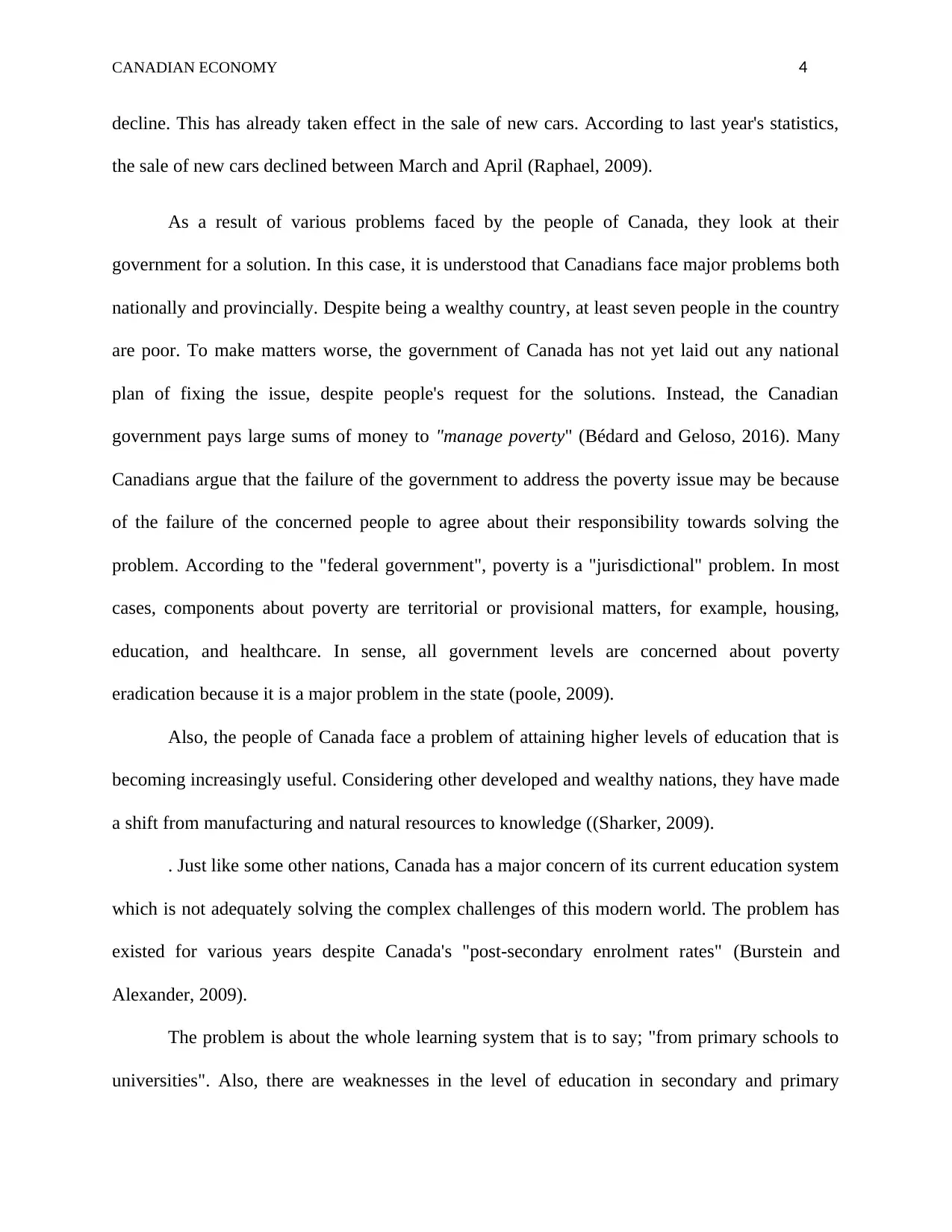
CANADIAN ECONOMY 4
decline. This has already taken effect in the sale of new cars. According to last year's statistics,
the sale of new cars declined between March and April (Raphael, 2009).
As a result of various problems faced by the people of Canada, they look at their
government for a solution. In this case, it is understood that Canadians face major problems both
nationally and provincially. Despite being a wealthy country, at least seven people in the country
are poor. To make matters worse, the government of Canada has not yet laid out any national
plan of fixing the issue, despite people's request for the solutions. Instead, the Canadian
government pays large sums of money to "manage poverty" (Bédard and Geloso, 2016). Many
Canadians argue that the failure of the government to address the poverty issue may be because
of the failure of the concerned people to agree about their responsibility towards solving the
problem. According to the "federal government", poverty is a "jurisdictional" problem. In most
cases, components about poverty are territorial or provisional matters, for example, housing,
education, and healthcare. In sense, all government levels are concerned about poverty
eradication because it is a major problem in the state (poole, 2009).
Also, the people of Canada face a problem of attaining higher levels of education that is
becoming increasingly useful. Considering other developed and wealthy nations, they have made
a shift from manufacturing and natural resources to knowledge ((Sharker, 2009).
. Just like some other nations, Canada has a major concern of its current education system
which is not adequately solving the complex challenges of this modern world. The problem has
existed for various years despite Canada's "post-secondary enrolment rates" (Burstein and
Alexander, 2009).
The problem is about the whole learning system that is to say; "from primary schools to
universities". Also, there are weaknesses in the level of education in secondary and primary
decline. This has already taken effect in the sale of new cars. According to last year's statistics,
the sale of new cars declined between March and April (Raphael, 2009).
As a result of various problems faced by the people of Canada, they look at their
government for a solution. In this case, it is understood that Canadians face major problems both
nationally and provincially. Despite being a wealthy country, at least seven people in the country
are poor. To make matters worse, the government of Canada has not yet laid out any national
plan of fixing the issue, despite people's request for the solutions. Instead, the Canadian
government pays large sums of money to "manage poverty" (Bédard and Geloso, 2016). Many
Canadians argue that the failure of the government to address the poverty issue may be because
of the failure of the concerned people to agree about their responsibility towards solving the
problem. According to the "federal government", poverty is a "jurisdictional" problem. In most
cases, components about poverty are territorial or provisional matters, for example, housing,
education, and healthcare. In sense, all government levels are concerned about poverty
eradication because it is a major problem in the state (poole, 2009).
Also, the people of Canada face a problem of attaining higher levels of education that is
becoming increasingly useful. Considering other developed and wealthy nations, they have made
a shift from manufacturing and natural resources to knowledge ((Sharker, 2009).
. Just like some other nations, Canada has a major concern of its current education system
which is not adequately solving the complex challenges of this modern world. The problem has
existed for various years despite Canada's "post-secondary enrolment rates" (Burstein and
Alexander, 2009).
The problem is about the whole learning system that is to say; "from primary schools to
universities". Also, there are weaknesses in the level of education in secondary and primary
Paraphrase This Document
Need a fresh take? Get an instant paraphrase of this document with our AI Paraphraser
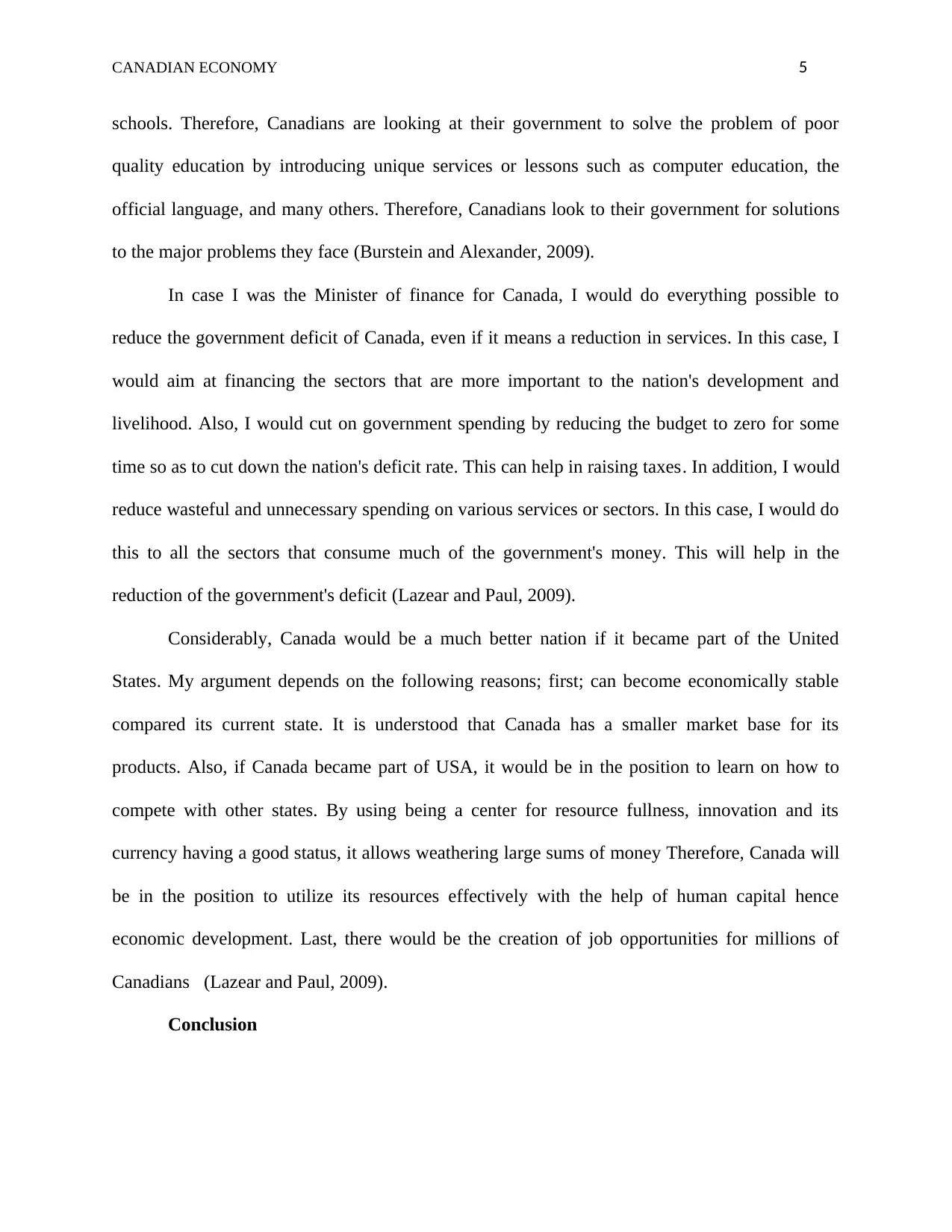
CANADIAN ECONOMY 5
schools. Therefore, Canadians are looking at their government to solve the problem of poor
quality education by introducing unique services or lessons such as computer education, the
official language, and many others. Therefore, Canadians look to their government for solutions
to the major problems they face (Burstein and Alexander, 2009).
In case I was the Minister of finance for Canada, I would do everything possible to
reduce the government deficit of Canada, even if it means a reduction in services. In this case, I
would aim at financing the sectors that are more important to the nation's development and
livelihood. Also, I would cut on government spending by reducing the budget to zero for some
time so as to cut down the nation's deficit rate. This can help in raising taxes. In addition, I would
reduce wasteful and unnecessary spending on various services or sectors. In this case, I would do
this to all the sectors that consume much of the government's money. This will help in the
reduction of the government's deficit (Lazear and Paul, 2009).
Considerably, Canada would be a much better nation if it became part of the United
States. My argument depends on the following reasons; first; can become economically stable
compared its current state. It is understood that Canada has a smaller market base for its
products. Also, if Canada became part of USA, it would be in the position to learn on how to
compete with other states. By using being a center for resource fullness, innovation and its
currency having a good status, it allows weathering large sums of money Therefore, Canada will
be in the position to utilize its resources effectively with the help of human capital hence
economic development. Last, there would be the creation of job opportunities for millions of
Canadians (Lazear and Paul, 2009).
Conclusion
schools. Therefore, Canadians are looking at their government to solve the problem of poor
quality education by introducing unique services or lessons such as computer education, the
official language, and many others. Therefore, Canadians look to their government for solutions
to the major problems they face (Burstein and Alexander, 2009).
In case I was the Minister of finance for Canada, I would do everything possible to
reduce the government deficit of Canada, even if it means a reduction in services. In this case, I
would aim at financing the sectors that are more important to the nation's development and
livelihood. Also, I would cut on government spending by reducing the budget to zero for some
time so as to cut down the nation's deficit rate. This can help in raising taxes. In addition, I would
reduce wasteful and unnecessary spending on various services or sectors. In this case, I would do
this to all the sectors that consume much of the government's money. This will help in the
reduction of the government's deficit (Lazear and Paul, 2009).
Considerably, Canada would be a much better nation if it became part of the United
States. My argument depends on the following reasons; first; can become economically stable
compared its current state. It is understood that Canada has a smaller market base for its
products. Also, if Canada became part of USA, it would be in the position to learn on how to
compete with other states. By using being a center for resource fullness, innovation and its
currency having a good status, it allows weathering large sums of money Therefore, Canada will
be in the position to utilize its resources effectively with the help of human capital hence
economic development. Last, there would be the creation of job opportunities for millions of
Canadians (Lazear and Paul, 2009).
Conclusion
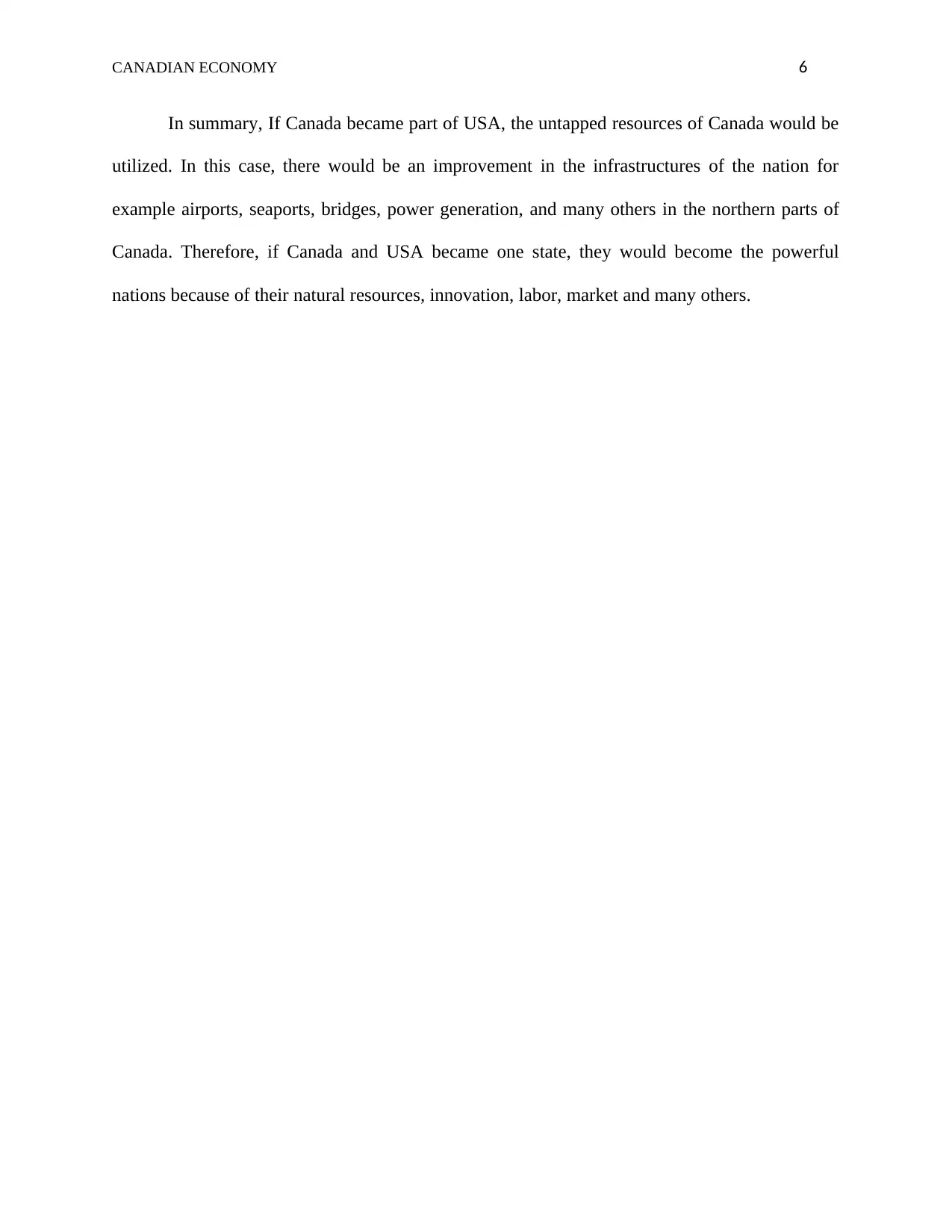
CANADIAN ECONOMY 6
In summary, If Canada became part of USA, the untapped resources of Canada would be
utilized. In this case, there would be an improvement in the infrastructures of the nation for
example airports, seaports, bridges, power generation, and many others in the northern parts of
Canada. Therefore, if Canada and USA became one state, they would become the powerful
nations because of their natural resources, innovation, labor, market and many others.
In summary, If Canada became part of USA, the untapped resources of Canada would be
utilized. In this case, there would be an improvement in the infrastructures of the nation for
example airports, seaports, bridges, power generation, and many others in the northern parts of
Canada. Therefore, if Canada and USA became one state, they would become the powerful
nations because of their natural resources, innovation, labor, market and many others.
⊘ This is a preview!⊘
Do you want full access?
Subscribe today to unlock all pages.

Trusted by 1+ million students worldwide
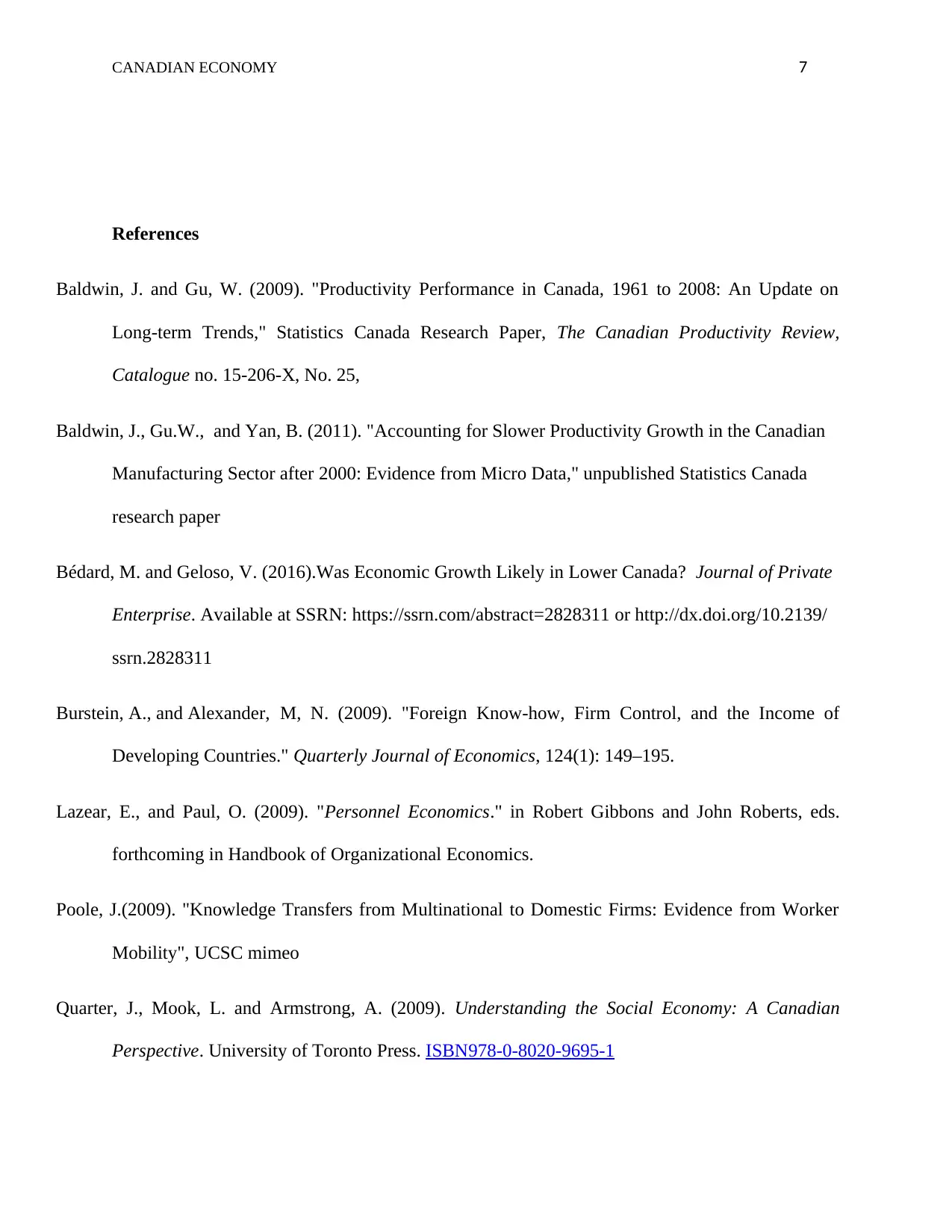
CANADIAN ECONOMY 7
References
Baldwin, J. and Gu, W. (2009). "Productivity Performance in Canada, 1961 to 2008: An Update on
Long-term Trends," Statistics Canada Research Paper, The Canadian Productivity Review,
Catalogue no. 15-206-X, No. 25,
Baldwin, J., Gu.W., and Yan, B. (2011). "Accounting for Slower Productivity Growth in the Canadian
Manufacturing Sector after 2000: Evidence from Micro Data," unpublished Statistics Canada
research paper
Bédard, M. and Geloso, V. (2016).Was Economic Growth Likely in Lower Canada? Journal of Private
Enterprise. Available at SSRN: https://ssrn.com/abstract=2828311 or http://dx.doi.org/10.2139/
ssrn.2828311
Burstein, A., and Alexander, M, N. (2009). "Foreign Know-how, Firm Control, and the Income of
Developing Countries." Quarterly Journal of Economics, 124(1): 149–195.
Lazear, E., and Paul, O. (2009). "Personnel Economics." in Robert Gibbons and John Roberts, eds.
forthcoming in Handbook of Organizational Economics.
Poole, J.(2009). "Knowledge Transfers from Multinational to Domestic Firms: Evidence from Worker
Mobility", UCSC mimeo
Quarter, J., Mook, L. and Armstrong, A. (2009). Understanding the Social Economy: A Canadian
Perspective. University of Toronto Press. ISBN978-0-8020-9695-1
References
Baldwin, J. and Gu, W. (2009). "Productivity Performance in Canada, 1961 to 2008: An Update on
Long-term Trends," Statistics Canada Research Paper, The Canadian Productivity Review,
Catalogue no. 15-206-X, No. 25,
Baldwin, J., Gu.W., and Yan, B. (2011). "Accounting for Slower Productivity Growth in the Canadian
Manufacturing Sector after 2000: Evidence from Micro Data," unpublished Statistics Canada
research paper
Bédard, M. and Geloso, V. (2016).Was Economic Growth Likely in Lower Canada? Journal of Private
Enterprise. Available at SSRN: https://ssrn.com/abstract=2828311 or http://dx.doi.org/10.2139/
ssrn.2828311
Burstein, A., and Alexander, M, N. (2009). "Foreign Know-how, Firm Control, and the Income of
Developing Countries." Quarterly Journal of Economics, 124(1): 149–195.
Lazear, E., and Paul, O. (2009). "Personnel Economics." in Robert Gibbons and John Roberts, eds.
forthcoming in Handbook of Organizational Economics.
Poole, J.(2009). "Knowledge Transfers from Multinational to Domestic Firms: Evidence from Worker
Mobility", UCSC mimeo
Quarter, J., Mook, L. and Armstrong, A. (2009). Understanding the Social Economy: A Canadian
Perspective. University of Toronto Press. ISBN978-0-8020-9695-1
Paraphrase This Document
Need a fresh take? Get an instant paraphrase of this document with our AI Paraphraser
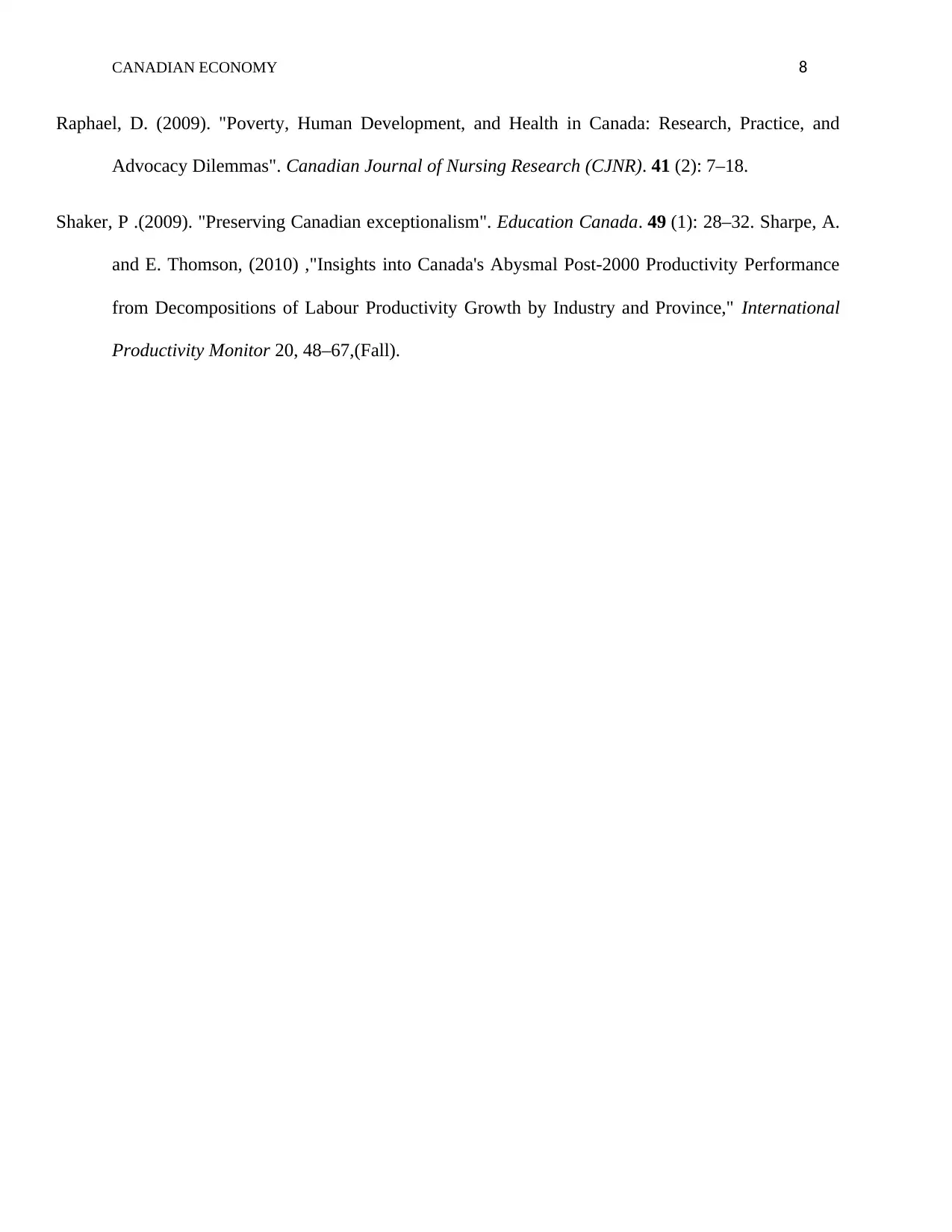
CANADIAN ECONOMY 8
Raphael, D. (2009). "Poverty, Human Development, and Health in Canada: Research, Practice, and
Advocacy Dilemmas". Canadian Journal of Nursing Research (CJNR). 41 (2): 7–18.
Shaker, P .(2009). "Preserving Canadian exceptionalism". Education Canada. 49 (1): 28–32. Sharpe, A.
and E. Thomson, (2010) ,"Insights into Canada's Abysmal Post-2000 Productivity Performance
from Decompositions of Labour Productivity Growth by Industry and Province," International
Productivity Monitor 20, 48–67,(Fall).
Raphael, D. (2009). "Poverty, Human Development, and Health in Canada: Research, Practice, and
Advocacy Dilemmas". Canadian Journal of Nursing Research (CJNR). 41 (2): 7–18.
Shaker, P .(2009). "Preserving Canadian exceptionalism". Education Canada. 49 (1): 28–32. Sharpe, A.
and E. Thomson, (2010) ,"Insights into Canada's Abysmal Post-2000 Productivity Performance
from Decompositions of Labour Productivity Growth by Industry and Province," International
Productivity Monitor 20, 48–67,(Fall).
1 out of 8
Related Documents
Your All-in-One AI-Powered Toolkit for Academic Success.
+13062052269
info@desklib.com
Available 24*7 on WhatsApp / Email
![[object Object]](/_next/static/media/star-bottom.7253800d.svg)
Unlock your academic potential
Copyright © 2020–2025 A2Z Services. All Rights Reserved. Developed and managed by ZUCOL.





